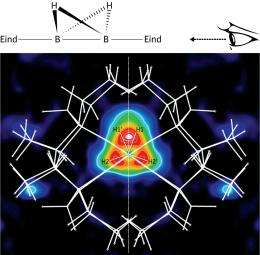Bulky molecules trap boron compounds into a never-before-seen structural arrangement

When it comes to chemical bonding, boron has a reputation for being unconventional. While covalent bonds are usually formed by sharing two electrons between two atoms, some compoundsâincluding diboranes (B2H6) âcontain BâHâB bonds in which an electron pair is distributed over three sites. The electron-deficient nature of these â3-center, 2-electronâ bonds can generate a variety of distinct chemical structures, some of whichâsuch as triple-bonded diborane derivativesâhave only been seen theoretically.
Kohei Tamao and colleagues from the RIKEN Advanced Science Institute in Wako and Kyoto University, Japan, have now isolated the first stable diborane molecule with butterfly-shaped BâHâB bonds and a boronâboron link with triple bond characteristics. This discovery unlocks new insights into the workings of 3-center, 2-electron boron interactions and puts scientists one step closer to synthesizing the elusive boronâboron triple bond.
The key to this approach is a bulky molecule known as âEindâ that contains a rigid core of fused hydrocarbon rings covered with ethyl side chains. Previously, the researchers used Eind ligands to stabilize heavy elements into multiply bonded species. This time, the team hoped to generate a neutral boronâboron double bond by substituting Eind groups for hydrogen atoms in diborane.
However, after characterizing the structure of the diboraneâEind compoundâa difficult task requiring synchrotron x-rays to detect hydrogen atom positionsâthe researchers saw a previously unidentified arrangement at the B2H2 core: a central boronâboron connection nearly as short as a theoretical triple bond, flanked by two symmetric BâHâB âwingsâ (Fig. 1). âWe did not expect this butterfly-shaped structure at first, and finding it was a kind of serendipity,â says co-author Yoshiaki Shoji.
Quantum computations revealed that the Eind ligands enforced a linear bonding geometry upon the boron atoms, creating molecular energy levels closely related to the triple-bond species. Furthermore, the bridging hydrogen atoms enhanced the multiple bonding characteristics. âBased on this analysis, it is possible to consider triple bonding interactions between the two boron atoms,â says team-member Tsukasa Matsuo.
Matsuo notes that the butterfly-shaped molecule already displays unique chemical reactivity, and the insights gained from this new structure could lead to additional multiply-bonded diboranes. âWe may be able to synthesize a more triply bonded species in the near future by replacing the bridging hydrogen atoms with alkali metals,â he says. âAt the moment, this compound is just a dream but I think we have a chance to obtain it.â
More information:
-- Shoji, Y, et al. A stable doubly hydrogen-bridged butterfly-shaped diborane(4) compound. Journal of the American Chemical Society 132, 8258â8260 (2010).
-- Li, B., et al. Ï-Conjugated phosphasilenes stabilized by fused-ring bulky groups. Journal of the American Chemical Society 131, 13222â13223 (2009)
Provided by RIKEN
















